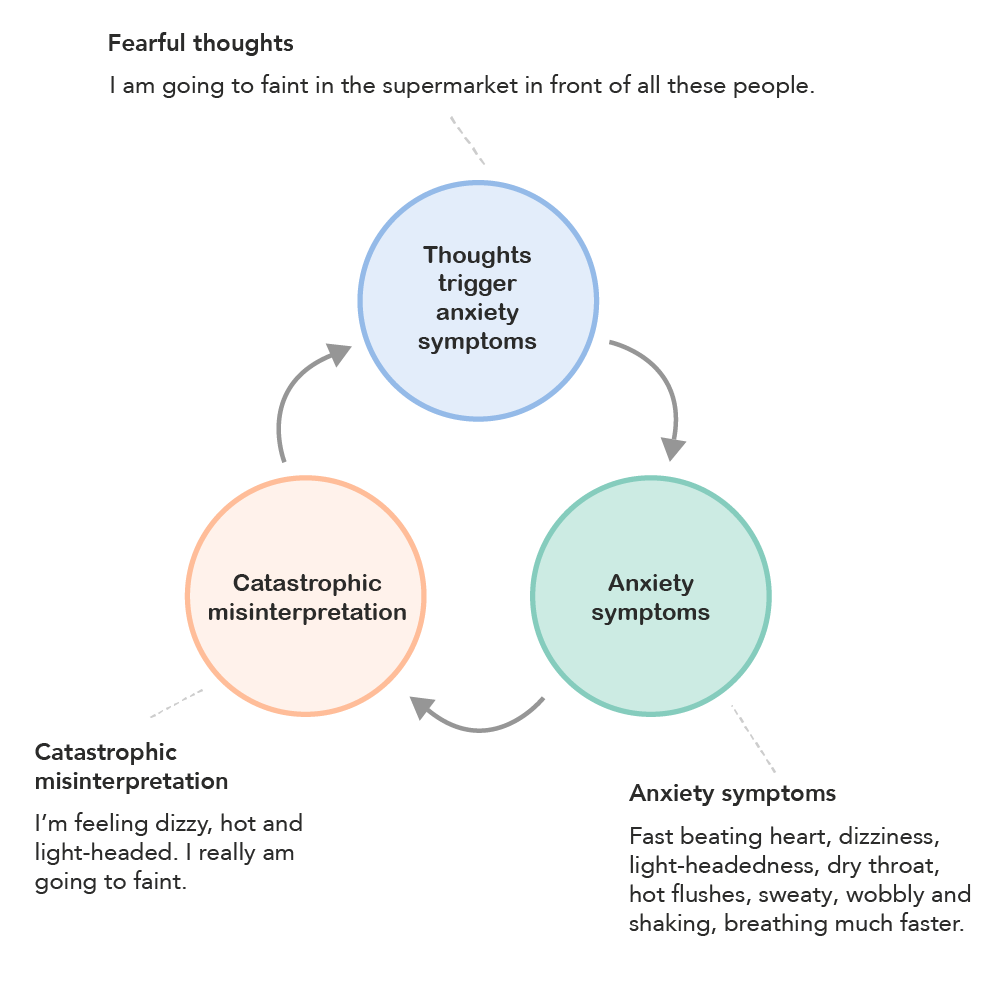Panic attacks are common – around 1 in 10 people will experience at least 1 attack in their lifetime. And it’s quite possible to experience 1 panic attack in a particular situation that caused you a high level of stress and not experience any more.
It’s not surprising, however, that once someone has experienced a panic attack they can start to fear having another one, especially in situations that are similar to when the first attack happened. They can also become very aware of the normal symptoms of anxiety, that we all have from time-to-time and worry that these are the signs of another panic attack starting. This worry can then make them feel even more anxious and this can help to keep panic attacks going.
It will help to look at our case study which shows how a vicious cycle can develop in which the fear of having a panic attack can make panicking more likely.
For us to understand what can help to keep panic attacks happening it’s also important to consider what professionals call ‘catastrophic misinterpretation’, ‘safety behaviours’ and ‘avoidance’.
Catastrophic misinterpretation
When someone starts to panic they can mistake the strong physical signs of anxiety as evidence that something terrible REALLY IS happening. This is known as catastrophic misinterpretation.
It’s common to think that a fast-beating heart is the sign of a heart attack starting, for example. Or someone can misinterpret the symptoms of anxiety (feeling dizzy or wobbly) as a sign that they are about to faint.
Common examples of catastrophic misinterpretation
| Symptom of anxiety | Common misinterpretation |
| Fast beating heart/palpitations | I’m having a heart attack |
| Dizziness and feeling wobbly | I’m going to faint or collapse |
| Shallow breathing | I’m going to stop breathing |
| Racing thoughts | I’m losing my mind |
| Feeling detached from reality | I’m going ‘crazy’ |
| Nummbness or tingling sensations | I’m having a stroke |
| Need to go to the toilet | I’m going to wet myself and embarrass myself in public |
| Reduced vision | I’m going blind |
Not surprisingly, someone who thinks that something terrible is happening is going to get even more anxious and scared. This can trigger another threat response making the physical sensations they’re experiencing even worse. And this helps to provide further ‘proof’ that something bad really is happening! Some people even seek emergency help thinking their physical health is in danger.
The Catastrophic misinterpretation diagram below shows how Suzanne, in our case study, mistakes the symptoms of anxiety (feeling dizzy, hot, wobbly and light-headed) as signs that she might be about to faint, making her even more anxious.

Read a description of the Catastrophic misinterpretation diagram
Download this diagram as a pdf:
Catastrophic misinterpretation
Safety behaviours
Many people who start to have panic attacks fear having another one. It’s only natural to want to do something to stop feeling panicky again. Safety behaviours are things you might do to feel safer and reduce your anxiety, in order to try and stop another panic attack from happening.
Common examples of safety behaviours include:
- carrying a water bottle (and medication) with you at all times
- standing next to a wall to lean on in case you feel faint
- listening to music on public transport to distract you from what’s going on
- only travelling with a friend
- sitting near the exit or bathroom
- going to the supermarket late at night
- asking for reassurance from others that everything is OK
While safety behaviours may reduce the discomfort you might be feeling, right now, you can become dependent on them and start to believe that you can’t do certain things without them.
What’s more, relying on safety behaviours can make you believe even more strongly that certain situations are putting you in actual danger. This can stop you from testing out just how dangerous situations really are, making it more likely that you will continue to have more panic attacks.
Avoidance
People who have experienced panic attacks say that they felt like the symptoms were taking over their whole body. This was so frightening they couldn’t think logically and had a strong urge to escape the situation and find safety.
It’s common for people who are experiencing panic attacks to start escaping from or avoiding situations where they’ve panicked before. This is known as avoidance. They may also start to avoid places where they feel more vulnerable, at risk, unable to escape, or under increased pressure, such as:
- A busy supermarket, a crowded train station or a packed shopping centre.
- In a cinema, theatre, sports arena, restaurant, train, airplane or in a lift.
- Being alone in the house (particularly at night) or driving a car.
- Speaking in front of a group of people.
- An environment where lots of decisions and actions are needed quickly – like being in a high-pressure workplace or in an exam, for example.
- Places that are noisy with bright lights and lots of distractions.
These are situations where we may feel less in control of what’s happening and experience certain thoughts, ideas or fears which may trigger an attack.
People can also start to avoid situations where they might experience panic-like symptoms such as exercising, having sex, drinking coffee or situations where they might need to express strong emotions.
Unfortunately, avoiding situations that you fear will mean that the next time you need to try and face the same situation the anxiety continues…
